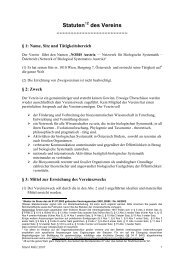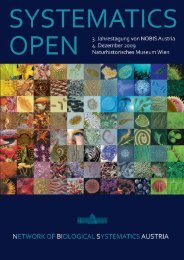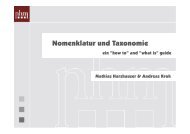4. Jahrestagung von NOBIS Austria 2. - 3. Dezember 2010
4. Jahrestagung von NOBIS Austria 2. - 3. Dezember 2010
4. Jahrestagung von NOBIS Austria 2. - 3. Dezember 2010
You also want an ePaper? Increase the reach of your titles
YUMPU automatically turns print PDFs into web optimized ePapers that Google loves.
Quantifying evolution – paleolake mollusks from the Dinaride<br />
Lake System (Middle Miocene, Sinj Basin, SE Croatia)<br />
Neubauer, T.A., Mandic, O. & Harzhauser, M.<br />
Department of Geology and Paleontology, Natural History Museum Vienna, Burgring 7, 1010 Vienna,<br />
<strong>Austria</strong><br />
e-mail: thomas@indmath.uni-linz.ac.at, oleg.mandic@nhm-wien.ac.at,<br />
mathias.harzhauser@nhm-wien.ac.at<br />
The present investigation deals with the mollusk evolutionary patterns and environmental change in a<br />
lower Middle Miocene succession in the Sinj Basin (Dalmatia, SE Croatia) reflecting the depositional<br />
history of a long-lived freshwater lake. Despite its mature investigation stage, an analysis of a<br />
quantified mollusk record, providing insight into species contributions, taxonomic relationships and the<br />
nature of the morphologic changes, is completely missing up to now.<br />
The taxonomic diversification of freshwater gastropods and its connection with morphologic disparity<br />
events are documented for a ca. 100-m-thick section representing the topmost infill of the Sinj Basin.<br />
Based on the available age model, these alterations occur extremely fast on a millennial scale, re-<br />
proving the significance of long-lived lakes for evolutionary research. Furthermore, the simultaneity of<br />
morphologic shifts in systematically independent taxa suggests them to be tightly linked to<br />
environmental changes. Most probably, climatic fluctuations leading to variations in lake-level and<br />
habitat types are the driving factors for these radiation events.<br />
The study provides statistical treatment of quantified samples accompanied by a taxonomic revision of<br />
the taxa. Additionally, based on the mollusk distribution a paleoenvironmental interpretation is given,<br />
supported by sedimentological data and previous palynological analysis. Actually, it supports previous<br />
results of the section’s division into two limestone-coal cycles, grading from shallow intermediate-<br />
energy settings with high freshwater input via fossil-poor transgressive limestones to shallow low-<br />
energy conditions, resulting finally in a total lake drought at the section top.<br />
The discussion will focus on the evolutionary lines of four species, two of Melanopsis and two of<br />
Prososthenia. All four species appear almost continuously and can be divided into several<br />
morphotypes based on different sculpture features; in some cases also size plays a role. It will be<br />
demonstrated that the morphs occur sequentially, each more or less limited to a special interval.<br />
Moreover, the changes in morphology appear at the same time in different taxa.<br />
_____________________________________________________________________________<br />
Ber. Inst. Erdwiss. K.-F.-Univ. Graz, Band 15, <strong>2010</strong>; ISSN 1608-8166 37






